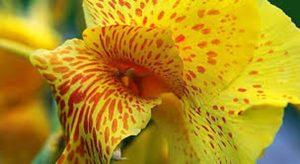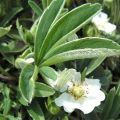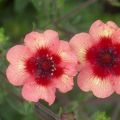Description and characteristics of Potentilla varieties Princess, planting and care
Cinquefoil has been known since ancient times. According to one of the legends, Ilya Muromets, in order to defeat the Nightingale the Robber, inhaled the smell of this flower. Now the culture can be found not only in the wild, the shrub is actively grown as an ornamental plant. One of the popular varieties is the Princess variety.
Description Potentilla Princesses / Pink Queen
Pink Queen cinquefoil is a medium-sized shrub. The crown is lush, spreading, in diameter from 1 to 1.2 m with light green leaves. The height of an adult bush is about 60-70 cm. Creeping crown type. The leaves are pinnate, below the silvery shade.
Inflorescences are pink with yellow stamens. The flowering period of the inflorescences begins in June and ends in September. It is better to plant a shrub in partial shade or in the sun. But in sunny areas, the flowers can fade to a white tint.
Comparative characteristics with the Cobalt variety
| Variety Princess | Cobalt grade | |
| Inflorescence color | Pink | Yellow |
| Bush height | From 60 cm | From 80 cm |
| Flowering period | June-September | From June to frost |
| Crown shape | Cushion | Rounded |
In general, there are no significant differences between these two varieties, except for the shade of the inflorescences.
The subtleties of growing a shrub
Growing Potentilla on the site is not the most difficult task. With the right place, the shrub will delight with abundant flowering for more than one season.
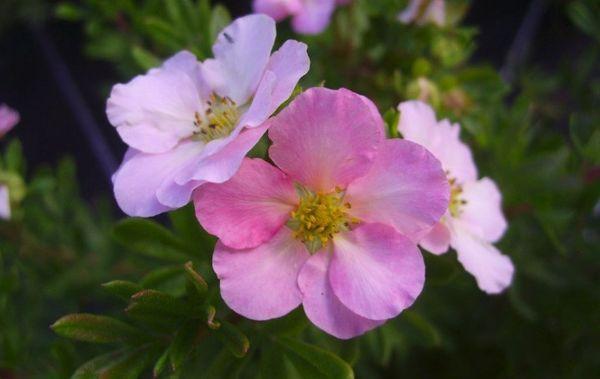
Choice of time and place
The choice of a place for planting a shrub depends on the variety. Some are unpretentious, and some varieties are quite capricious. Fortunately, the Pink Queen variety is unpretentious and can grow normally in partial shade and in the sun.
You can plant seedlings at any time, but early spring is considered the most favorable. In open ground, seedlings are planted at the end of April after the soil warms up. In the fall, the shrub is planted a month before the expected onset of frost.
Pink Queen cinquefoil is demanding on the composition of the soil. The shrub prefers to grow in areas with good drainage and acidity levels in the range of pH 5.7-7.
Preparation of planting material
It is necessary to prepare the planting material for Potentilla one day before planting in open ground. For this, the root system of the seedling is placed in a growth activator and left in it for 12 hours.
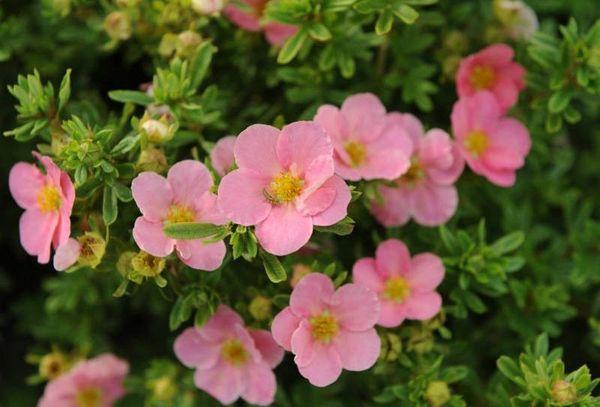
Immediately before planting in open ground, the rhizome is dipped in a liquid clay solution.This will help protect the root system from developing diseases.
Landing technology
Prepare a site for planting Potentilla begins 2 weeks before planting. A hole is dug to a depth of 70-90 cm. 15 cm of drainage is poured into the bottom. Then they fall asleep in equal parts of humus and leafy soil, add mineral fertilizers. You can also add a small amount of sand.
Sapling planting process:
- Before planting, the roots are trimmed at the bush.
- Install it in the hole, carefully separating the roots before this.
- The hole is covered with soil, tamped near the stem.
At the end of planting, the seedling is watered with plenty of warm water. The distance between adjacent bushes is at least 1 m.
Tips for caring for Potentilla
Pink Queen cinquefoil is a demanding variety. The shrub needs crown formation and regular fertilization.
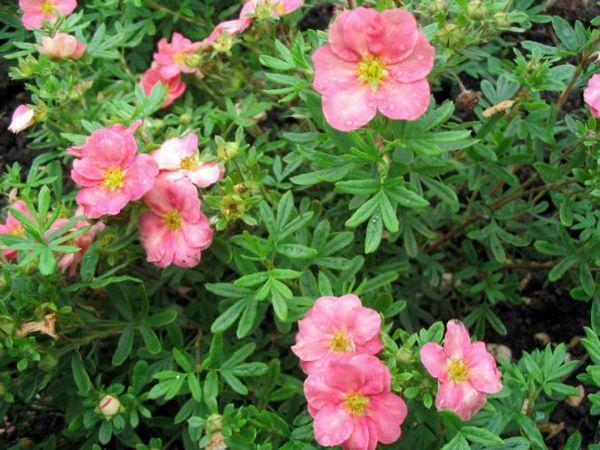
Irrigation scheme
The shrub does not need frequent watering. It is enough to irrigate the soil once every two weeks. And if it rains, even less. For watering shrubs, water heated in the sun is used.
To increase the number of inflorescences after sunset, the plant is sprayed with water from a hose.
Top dressing and fertilizers
You need to feed the shrub three times a year - in May, July and September. Complex mineral fertilizers are used as top dressing.
Trimming the plant
The formation of the crown is carried out in the spring before the buds begin to bloom. Sanitary pruning is done in the fall. If you do not cut the bush, very quickly it will become ugly and untidy.
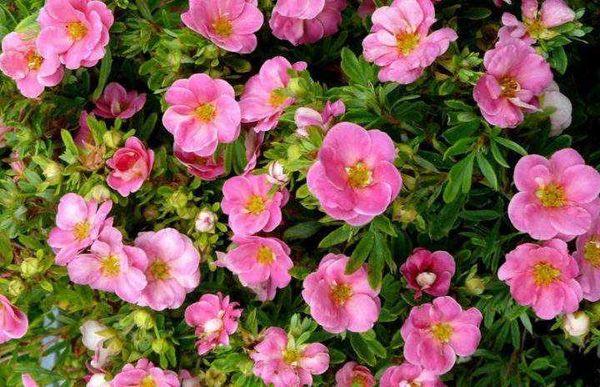
In the spring, the shrub is given the necessary shape and all branches that interfere with it are cut off. In autumn, dry and diseased branches are removed from Potentilla. Sharp garden shears are used for pruning. Places of cuts at the plant are treated with garden varnish or wood ash.
Protection against diseases and pests
Cinquefoil is one of those cultures that rarely infect diseases if properly cared for. Among the diseases on the plant are powdery mildew, rust and spotting. You can get rid of these diseases by spraying with fungicides.
Of the pests on the cinquefoil, the scoop is found. Insecticides will help to destroy the pest. As a preventive measure, you need to cut off dry branches every autumn, do not plant bushes too close to each other and prevent weeds from growing.
Breeding methods of the variety
One of the ways of reproduction of Potentilla is cuttings. Cuttings are prepared in August. They are cut from the lower shoots, after cutting off the inflorescences. The length of the cuttings should not be less than 10 cm. They can be planted immediately in open ground, covered with a bottle.
If inflorescences begin to appear, they are cut off. For the winter, the bottles are not removed, they are only covered with spruce branches.
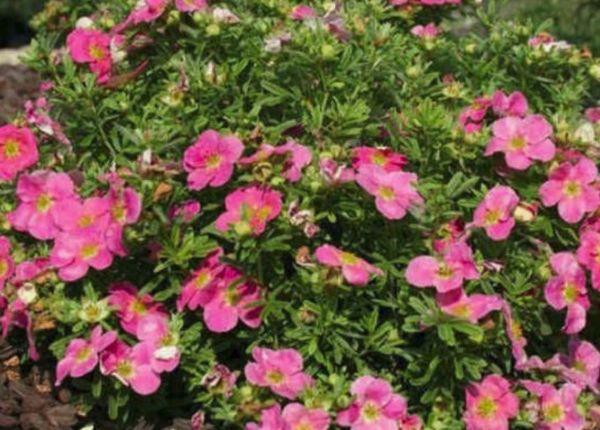
Another way is seed. For this, planting material is planted in March for seedlings. And in the spring, when the soil warms up, the seedlings are transplanted into open ground.
Potentilla also reproduces by layering. In the spring, the strongest lower stem is bent to the soil and buried in earth. By the fall, the roots will form on the branch, the layers can be separated from the mother bush and planted.
The easiest way to reproduce is by cutting the bush into several parts. The bush is dug up and cut into several pieces with a shovel. Then they are seated.
Use in landscape design
Pink Queen cinquefoil is used to decorate summer cottages and landscape design. The shrub is planted as hedges. Thanks to the spreading crown, such hedges look very impressive. Cinquefoil looks great in single and group plantings. The plant is compatible with most flower crops.

